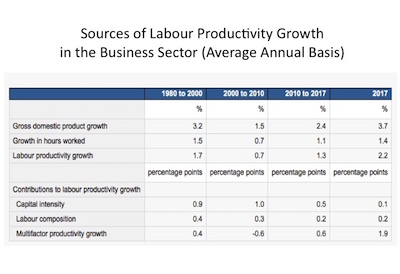Multifactor Productivity Rose 1.9% in 2017

Mar 18, 2019
Multifactor productivity, measured as output per unit of combined labour and capital inputs, rose 1.9% in the Canadian business sector in 2017, following no growth in 2016 and a 1.0% decline in 2015. The increase in 2017 reflected 3.7% growth in output and a 1.8% gain in the combined inputs of capital and labour.
These estimates incorporate the most recent supply-use tables, and the latest estimates for fixed capital, hours worked and gross domestic product.
Multifactor productivity measures the extent to which inputs are used efficiently in the production process. Growth in multifactor productivity is often associated with technological change, organizational change or economies of scale.
Multifactor productivity is one of the three components of labour productivity, the other two being capital intensity and upgrading labour skills. Labour productivity in the business sector increased 2.2% in 2017, mostly due to growth in multifactor productivity (+1.9 percentage points). Capital intensity (+0.1 percentage points) and skills upgrading (+0.2 percentage points) also contributed to the increase.
The rebound in multifactor productivity growth in 2017 mirrors the performance in the post-recession period
Productivity growth in the Canadian business sector increased after the financial crisis of 2008 and 2009, following a decade of weak growth. Labour productivity growth rose an average of 1.3% per year from 2010 to 2017, compared with 0.7% per year from 2000 to 2010.
The increase in labour productivity growth after 2010 was entirely due to an increase in multifactor productivity growth over that period. From 2010 to 2017, multifactor productivity rose 0.6% per year, stronger than the average annual multifactor productivity growth from 1980 to 2000 (+0.4%).
Source: Statistics Canada, www150.statcan.gc.ca/n1/daily-quotidien/190308/dq190308e-eng.htm











